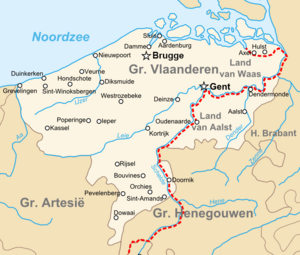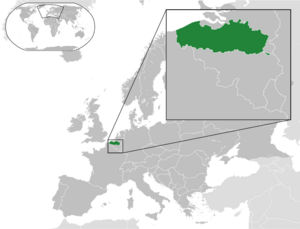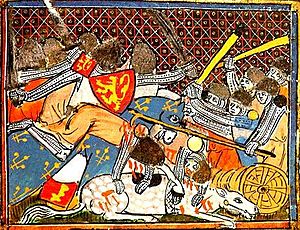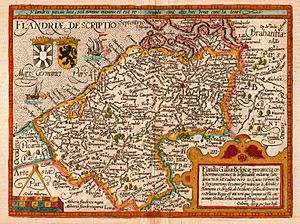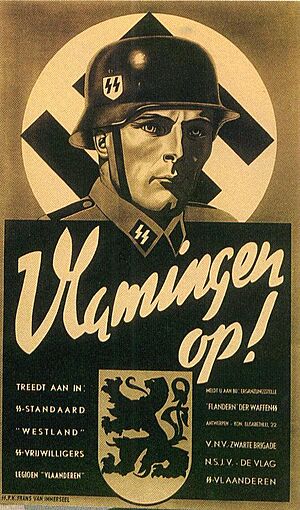History of Flanders facts for kids
The history of Flanders is about more than just the Dutch-speaking part of Belgium we call "Flanders" today. It also includes nearby lands and people. The original heart of Flanders was in western Belgium, between the coast and the Scheldt river.
The old county of Flanders started near Bruges. Its capital later moved to nearby Ghent. This county included parts of what is now French Flanders in France. It also covered the Belgian provinces of West Flanders and East Flanders. Part of the modern province of Hainaut was also included. For a long time in the Middle Ages, Flanders was a strong, almost independent state. It was part of the Kingdom of France but also reached into the Holy Roman Empire. Flanders was important to many nearby areas, including England. At its largest, its power spread north into Zeelandic Flanders (now in the Netherlands). It also went deep into French-speaking northern France.
Today, "Flanders" usually means the Flemish Region. This is the Dutch-speaking part of Belgium. It contains the old core of the county, West Flanders and East Flanders. It also has three other provinces to the east that are culturally similar. These are Antwerp and Flemish Brabant, which were part of the Duchy of Brabant. The province of Belgian Limburg was part of the Prince-Bishopric of Liège. The city of Brussels was historically part of Brabant. It is now part of the Flemish Community, but not the Flemish Region.
Contents
Early History of Flanders
Written records about the Flanders region began in Roman times. Julius Caesar wrote about his time there in his book, Commentaries of the Gaulish War. Caesar called "Belgium" or "Gallia Belgica" the northern part of Gaul. All of Flanders is within this large Belgic area. The people living there were called Belgae. Their land stretched from the North Sea to the Marne and Seine rivers. It also reached the Ardennes mountains and the Rhine river.
The old County of Flanders was home to the Menapii tribe. Their land went from the Rhine–Meuse–Scheldt delta to the modern Flemish coast. Across the Scheldt river, the Nervii lived. They stretched from Brabant into modern France. The eastern part of modern Flanders was home to the Eburones. Their land included most of Belgian Limburg and parts of Germany. The exact borders of these tribes are not fully known. All of them joined forces to fight against Caesar.
Later, under Roman rule, each tribe had its own "civitas" or state. Each state had a Roman capital city. For the Menapii, this was Cassel. For the Nervii, it was Bavay. Both are now in northern France. The only capital city now in Flanders was Tongeren. This was the capital of the Tungri, who replaced the Eburones.
Historians still debate if these tribes were Celtic, Germanic, or something else. But the Belgic area was influenced by both Celtic and Germanic cultures. Caesar wrote about tribes with Celtic names. But he also said that most Belgae had ancestors from east of the Rhine. This was before the Cimbri and Teutones migrations. Caesar said northern Belgic tribes like the Menapii and Nervii were different from Celtic Gauls. He called their eastern neighbors, like the Eburones, "Cisrhenane Germani." He reported German ancestors among these tribes. By the first century BC, Germanic languages may have been common in northern Belgium.
Later, as the Roman Empire faced attacks, the coast of Flanders became part of the "Saxon Shore." This was a military zone attacked by "Saxon" raiders from northern Germany. Inland Flanders, Brabant, and Limburg were attacked by Frankish tribes from across the Rhine. Forts like Oudenburg were built then. Eventually, the inland Salian Franks became Christian. They came to rule northern France and all of Belgium. They were seen as Rome's successors. But attacks from northern Germanic Vikings continued into the Middle Ages.
The County of Flanders
The County of Flanders was formed in 862. It was a feudal area in West Francia, which later became the Kingdom of France. Flanders grew powerful within France. But it was later divided. Its western parts came under French rule in the late 1100s. The rest of Flanders came under the counts of Hainaut in 1191.
Flanders grew stronger from the 1100s. Its independent cities, called communes, helped defeat a French attempt to take over. This happened between 1300 and 1302. The Flemish finally beat the French in the Battle of the Golden Spurs on July 11, 1302. This battle was near Kortrijk. Two years later, the uprising was defeated. Flanders remained indirectly part of the French Crown.
Flanders' wealth decreased in the next century. This was due to the Black Death in 1348, which killed many people. Trade was also disrupted during the Anglo-French Hundred Years' War (1338–1453). Also, English cloth production increased. Flemish weavers had moved to Norfolk, England, in the 1100s. They helped start the wool industry there.
In 1384, the whole area went to the dukes of Burgundy. They later joined Flanders with their Duchy of Brabant within the Holy Roman Empire. By 1556, the Burgundian Netherlands were ruled by the Habsburg kings of Spain. By this time, Flanders was no longer part of France. However, some western parts of Flanders came under French rule later. This happened through treaties in 1659 (Artois), 1668, and 1678.
In the late Middle Ages, Flanders' trading towns were very important. Ghent, Bruges, and Ypres were famous. They made Flanders one of the richest and most urbanized parts of Europe. They wove wool from nearby lands into cloth for use at home and for export. Because of this, a very advanced culture grew. There were amazing achievements in art and architecture. These were as good as those in Northern Italy. Ghent, Bruges, Ypres, and the Franc of Bruges formed the "Four Members." This was like a parliament that had a lot of power in Flanders.
Flanders in the Low Countries
Religious Changes and Conflict
In 1500, Charles V was born in Ghent. He inherited the Seventeen Provinces in 1506. He also inherited Spain and its colonies in 1516. In 1519, he became Holy Roman Emperor. Charles V made a rule in 1549 called the Pragmatic Sanction of 1549. This made the Low Countries, or Seventeen Provinces, separate from the Holy Roman Empire and France. In 1556, Charles V gave up his power because he was sick. Spain and the Seventeen Provinces went to his son, King Philip II of Spain.
Meanwhile, Protestantism had reached the Low Countries. Among the rich traders of Antwerp, Lutheran ideas became popular. This was perhaps for economic reasons. The spread of Protestantism in Antwerp was helped by an Augustinian monastery there. Martin Luther, who started Lutheranism, was an Augustinian himself. His writings were printed by 1518. The first Lutheran martyrs came from Antwerp. The Reformation brought different waves of change. First came Lutheranism, then Anabaptists, then Mennonites, and finally Calvinists. These groups existed separately.
Philip II was a strong Catholic. He wanted to stop Calvinism in Flanders, Brabant, and Holland. In 1566, the iconoclasm (Beeldenstorm) began. This was a protest against Philip II. People damaged statues and paintings of saints. This was linked to a religious war between Catholics and Protestants. The Beeldenstorm started in what is now French Flanders. It began with open-air sermons. The first one was near Hondschoote. The largest was near Boeschepe on July 12, 1562. These sermons, mostly Anabaptist or Mennonite, spread. On August 10, 1566, the chapel of the Sint-Laurensklooster was damaged by Protestants. This iconoclasm destroyed Catholic art and cost many priests their lives. It spread to Antwerp, then to Ghent on August 22. One cathedral, eight churches, twenty-five monasteries, ten hospitals, and seven chapels were attacked. From there, it spread east and north. But it lasted less than a month.
The Eighty Years' War
After these events, Philip II sent the Duke of Alba to the Provinces. His job was to stop the revolt. Alba took back the southern part of the Provinces. These areas signed the Union of Atrecht. This meant they would accept Spanish rule if they had more freedom. But the northern provinces signed the Union of Utrecht. In 1581, they formed the Republic of the Seven United Netherlands.
Spanish troops quickly fought the rebels. But before the revolt could be fully crushed, a war started between England and Spain. This made Philip's Spanish troops stop their advance. Meanwhile, the Spanish armies had already taken the important trading cities of Bruges and Ghent. Antwerp, which was then a very important port, also had to be conquered. On August 17, 1585, Antwerp fell. This ended the Dutch Revolt for the Southern Netherlands. The United Provinces (the Netherlands) kept fighting. This became known as the "Eighty Years' War," lasting until 1648. It ended with the Peace of Westphalia.
While Spain was at war with England, the northern rebels grew stronger. Many refugees from the south joined them. They began to reclaim areas lost to Spanish troops. They took a large part of Brabant (now North Brabant in the Netherlands). They also took the south bank of the Scheldt estuary (Zeelandic Flanders). Spanish troops stopped them there. The front line at the end of this war became the current border between Belgium and the Netherlands. The Dutch managed to take enough of Spanish-controlled Flanders to close off the Scheldt river. This cut Antwerp off from its trade routes.
The fall of Antwerp to the Spanish and the closing of the Scheldt caused many people to leave the city. Many Calvinist merchants from Antwerp and other Flemish cities moved north. A large number settled in Amsterdam. Amsterdam was a smaller port then, mainly for trade in the Baltic Sea. In the following years, Amsterdam quickly became one of the world's most important ports. Because Flemish exiles helped with this, their move is sometimes called "creating a new Antwerp."
Flanders and Brabant faced a period of decline after these events. This lasted from the time of the Thirty Years War. However, in the Northern Netherlands, the large number of people moving from Flanders and Brabant helped start the Dutch Golden Age.
Later Rule and Changes
Even though art stayed strong for another century with Peter Paul Rubens and Anthony van Dyck, Flanders lost its economic and intellectual power. This happened under Spanish, Austrian, and French rule. High taxes and strict imperial control made things worse. Industry stopped growing, and there were conflicts between Spain and the Dutch, and France and Austria. The Southern Netherlands suffered badly during the Spanish Succession war. But under Empress Maria-Theresia, these lands became rich again. The Austrian emperor Joseph II was influenced by the Enlightenment. He was the first ruler to visit the Southern Netherlands since King Philip II of Spain left in 1559.
French Revolution and Napoleon
In 1794, the French Republican Army started using Antwerp as France's northernmost naval port. France officially took over Flanders the next year. It became French "départements" called Lys, Escaut, Deux-Nèthes, Meuse-Inférieure, and Dyle. All men aged 16–25 had to join the French army. This was a main reason for the people's uprising against the French in 1798. It was known as the Boerenkrijg (Peasants' War). The worst fighting was in the Campine area.
United Kingdom of the Netherlands
After Napoleon Bonaparte was defeated at the 1815 Battle of Waterloo in Waterloo, the Congress of Vienna gave the Austrian Netherlands to the United Netherlands. This new state was led by Prince William I of Orange Nassau, who became King William I of the United Kingdom of the Netherlands. The French Empire had been driven out of Dutch lands. The United Kingdom of the Netherlands was born.
The Protestant King William I quickly started to industrialize the southern parts of the Kingdom. However, the political system slowly failed to unite the northern and southern parts. The southern middle class was mainly Roman Catholic, while the north was mostly Protestant. Also, many in the southern middle class spoke French, not Dutch.
In 1815, the Dutch Senate was brought back. The nobility, mostly from the south, felt more and more different from their northern colleagues. Both Roman Catholics from the south and Protestants from the north felt unhappy. The powerful liberal middle class from the south also disagreed with their more moderate northern colleagues. On August 25, 1830, after an opera in Brussels, the Belgian Revolution began. On October 4, 1830, the Provisional Government declared independence. This was later confirmed by the National Congress. They wrote a new Liberal Constitution and made the new state a Constitutional Monarchy under the House of Saxe-Coburg. Flanders now became part of the Kingdom of Belgium. Major European powers recognized Belgium on January 20, 1831. The Netherlands only officially recognized Belgium's independence on April 19, 1839.
Kingdom of Belgium
Birth of Belgium and Flemish Rights
In 1830, the Belgian Revolution split the two countries. Belgium became an independent state by the Treaty of London in 1839. But it lost the eastern half of Limburg (now Dutch Limburg) and the eastern half of Luxembourg (now the Grand-Duchy of Luxembourg). Zeelandic Flanders, south of the Westerscheldt river, stayed with the Kingdom of the Netherlands. The Netherlands could charge a toll on all ships going to Antwerp harbor until 1863.
The Flemish Movement
The Belgian Revolution was not very popular in Flanders. Even on October 4, 1830, when Belgium declared independence, Flemish leaders refused to obey the new Belgian government. Flanders only truly became part of Belgium after a large French military force helped control it a month later. The situation with Limburg province was unclear until 1839. Then, it was finally split between the Netherlands and Belgium.
The French-speaking upper class showed little respect for the Flemish people. French became the only official language in Belgium. All secondary and higher education in Dutch was stopped. Charles Rogier, one of Belgium's founders, wrote in 1832 that French should be the only language. He said that all important jobs should go to French speakers. This way, Flemings would have to learn French, and the "Germanic element" in Belgium would disappear.
In 1838, another founder, Senator Alexandre Gendebien, even said that Flemings were "one of the more inferior races on the Earth."
In 1834, people suspected of being "Flemish minded" or wanting to reunite with the Netherlands were punished. Their homes were looted and burned. Flanders, which had been a rich European region, was not seen as worth investing in. A study in 1918 showed that 80% of Belgium's money was invested in Wallonia in the first 88 years. This led to widespread poverty in Flanders. About 300,000 Flemish people moved to Wallonia to work in heavy industry.
All these events led to a quiet protest in Flanders against French-speaking control. But it was not until 1878 that Dutch was allowed for official use in Flanders. French still remained the only official language in Belgium.
A famous case happened in 1872. Jozef Schoep, a Fleming, went to the town hall to declare his son's birth. The official wrote down Schoep's Dutch words in French and spoke French to him. Schoep did not understand and left without signing, as a protest. The court in Brussels fined him. Schoep refused to accept this. His lawyers said they would speak in Dutch. The judge at first said no, but then changed his mind. The lawyers could use Dutch, but their words had to be translated into French. This was because the judges did not know Dutch. Schoep's lawyers also wanted the State's plea translated, but the court said no. The case went to the supreme court. It ruled that speaking Dutch in court was forbidden. It said that no judge had to know any language other than French. Mr. Schoep's son had to wait until 1882 to get a legal birth certificate. By then, his father had died.
One year later, Dutch was allowed again in secondary schools. The first one reopened in 1889. Flemings had to wait until 1919 for their language to be officially recognized. This was after many Flemish soldiers died in World War I. They waited until 1930 for the first Flemish university to reopen.
The first Dutch translation of the Belgian constitution was not published until 1967.
World War I and Its Impact
Flanders and Belgium saw huge losses of life during World War I. Especially in the three battles of Ypres. Hundreds of thousands died at Ypres. The poppies that grew on the battlefields became a symbol for lives lost in war. This was made famous by the poem "In Flanders Fields."
Flemish identity and awareness grew because of the war. The German occupiers took some actions that favored Flemings. More importantly, many Dutch-speaking soldiers were led by French-speaking officers. This helped spark Flemish independence efforts. The French-speaking officers often gave orders only in French. The suffering from this is still remembered by Flemish groups. They hold a yearly Yser pilgrimage in Diksmuide at the Yser Tower monument.
Flemish Autonomy Today
After World War II, differences between Dutch-speaking and French-speaking Belgians became clear. This led to conflicts, like whether King Leopold III should return. Most Flemings supported him, but Walloons did not. Another conflict was about using Dutch at the Catholic University of Leuven.
Because of these issues, Belgium changed its government structure. It went from a single state to a federal state. This created communities, regions, and language areas. This also led to the creation of a Flemish Parliament and Government.
Some Flemish parties still want more Flemish self-rule. Some even want Flanders to be independent. French-speakers, however, want to keep the current state as it is. Recent governments have given more power from the federal level to the regional governments.
On December 13, 2006, a fake news report by a Belgian French-speaking TV station said Flanders had decided to declare independence.
The 2007 federal elections showed more support for Flemish self-rule. All parties that wanted more Flemish power gained votes and seats in parliament. This was especially true for the Christian Democratic and Flemish party and the New Flemish Alliance (N-VA). The 2009 regional elections also strengthened parties wanting more Flemish power. CD&V and N-VA were the clear winners. N-VA even became the largest party in Flanders and Belgium in the 2010 federal elections.
These wins for parties wanting more Flemish self-rule match opinion polls. These polls show a steady increase in public support for their goals. Since 2006, some polls have even shown a majority in favor of Flemish independence. These polls are not yet fully representative, but they show a long-term trend.
Negotiators tried to form a federal government after the June 10, 2007, elections. But disagreements between Flemish and Walloon politicians about further state reform continued. This made it hard to form a government. It eventually led to the government falling and new elections on June 13, 2010. These elections were won by the pro-independence N-VA party in Flanders. The long process of forming a government in 2010 broke the previous record from 2007.
See also
- History of Belgium
- History of Wallonia
- History of Belgian Limburg


